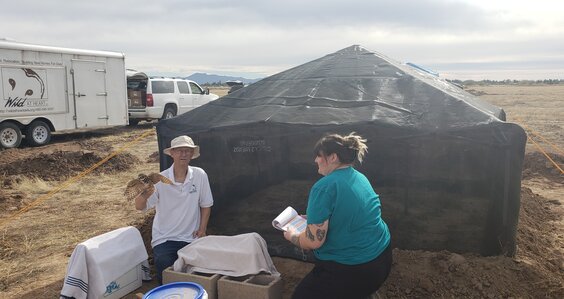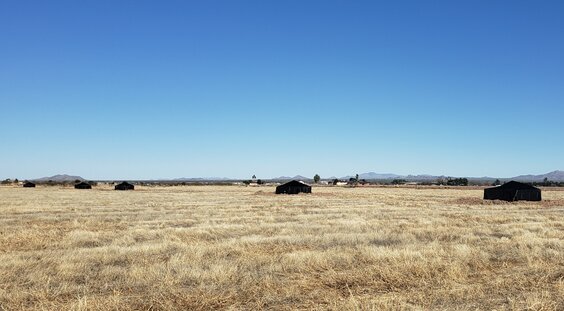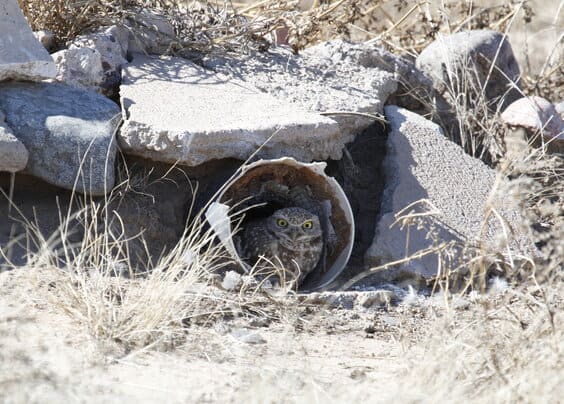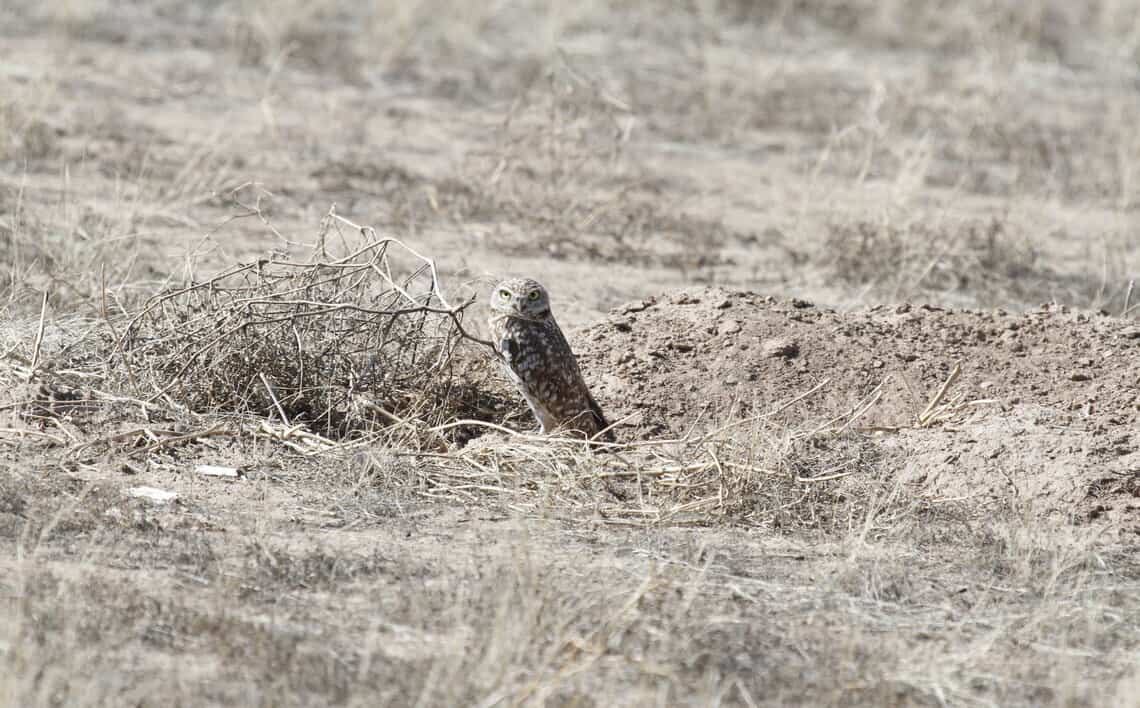By Emily Clark, Sonoran Joint Venture
It’s not hard to guess why the American Birding Association named the Burrowing Owl its 2022 Bird of the Year. Their bright yellow eyes, curious and charismatic demeanor, and propensity for daytime activity make this owl a big hit for birders. Even more incredibly, they are the only bird of prey to nest underground. While the name implies that they dig the holes themselves (and some do, especially in Florida), Burrowing Owls in the West prefer to use tunnels pre-excavated by mammals. Historically, Burrowing Owls used burrows created by prairie dogs. As prairie dog colonies have declined, western Burrowing Owls may now be more likely to use burrows created by species like ground squirrel, skunk, coyote, or those dug by tortoises. The owls form colonies in which mostly monogamous breeding pairs defend a nesting burrow during breeding season. Non-breeding and wintering owls may move from burrow to burrow or even roost in tall grass. Burrowing Owls hunt both during the day and at night, and feed on a variety of insects as well as small mammals and birds. They occur year-round in the lower half of Arizona, preferring grasslands and other arid habitats, but are often found in agricultural areas, golf courses, vacant lots, or other spots prime for confrontation with human activity.

While they are still considered widespread and numerous in the U.S., Burrowing Owl populations have declined by about 33% between 1966 and 2015, according to the North American Breeding Bird Survey. They are listed as a Bird of Conservation Concern for the USFWS, a species of Special Protection in Mexico, and Endangered in Canada. Human activity has played the largest role in their decline. In Arizona, and the greater Phoenix area in particular, intensive agriculture, extreme pressure from the housing market, and solar development have all taken a big chunk out of the available habitat for Burrowing Owls. Prior to construction, owls usually get flushed from their burrows and become displaced. They become vulnerable to predators and without a reliable food source they most likely will die. Stragglers that remain in their burrows are at risk from being buried alive during the construction process.
Recognizing the need to find suitable replacement habitat for these owls, in 1993 the founders of Wild At Heart created a relocation program in Arizona, constructing the first artificial underground burrow. Since then, this Phoenix-based rescue, rehabilitation, and release center for birds of prey has become a world-renowned leader in Burrowing Owl relocations. Greg Clark, who has served as Wild At Heart’s Burrowing Owl Habitat Coordinator since 2001, leads this effort. The organization has accrued a dedicated network of volunteers to help with field work and follow-up care. They have also partnered with many organizations and researchers to study the most effective way to carry out relocations. Their numbers are quite astounding, having installed close to 7000 burrows and relocated about 3000 Burrowing Owls (Greg Clark, personal communication, March 28, 2022). However, the process of finding new suitable sites and either towns or private landowners willing to host these owl colonies is a constant battle.

At the December 2021 Arizona Bird Conservation Initiative meeting, the Burrowing Owl Working Group, led by Arizona Game and Fish Department and partners, put out a call for volunteers to help with a relocation effort planned for Marana, Arizona, north of Tucson. After a lengthy reconnaissance and safe capture process at the future development site, owls are brought to the Wild at Heart facility for medical care and genetic testing to determine sex prior to being relocated.
In early January 2022, a large group of volunteers mainly associated with Wild At Heart, as well as a large number of Pima County Master Naturalists, gathered to build a series of small release tents surrounding a series of artificial burrows constructed at an agricultural site in Marana. This spot was already home to a group of relocated owls, and the new releases would be adding to the colony. Wild At Heart released thirteen pairs of Burrowing Owls (26 banded individuals) into their designated tents where the birds would spent another 30 days adjusting through a “soft-release” process. During this time, the birds became habituated to their new site while being protected from predators and fed by volunteers. A group of seven care volunteers (including the author) took turns visiting the colony to record any disturbance to the tent area and note whether the owls were eating, as well provided fresh water and mice. Over time, the owls became territorial, meaning they will stay put once the soft-release tents come down.

After the soft-release, another group of volunteers gathered to carefully remove the tents. Many birds stay at their original burrow, but the team also opened a series of new burrows at the release site so that the owls are free to move and change mates if they did not bond with their release partner. The care volunteers continued to feed the released owls at the original site locations for the next week as the owls got used to hunting again. After that, the team mostly left the colony to its own devices, with periodic checks on welfare and for predator activity.
As these Burrowing Owls make Marana their home, the work continues with other displaced owls. A research team from various organizations is also evaluating the effectiveness of different techniques with the goal of making relocations as successful as possible. If you are interested getting involved in the project, or know of a suitable release site, please reach out.

